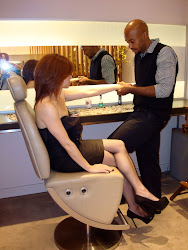Mischo Beauty School: Hair Porosity 101
I've received a few emails asking me to discuss the reason(s) why hair becomes damaged and dry after certain chemical services. Well, there could quite possibly be hundreds of answers to those questions depending on the history of services performed on the hair, and the home care regimen. I will say that if your hair is damaged and overly dry, then your hair's porosity has probably been compromised.
So, what is porosity? Porosity is simply the ability of the hair to absorb and retain moisture and is used to describe the condition of hair. Generally, it falls into the following categories:
a. Very porous
b. Porous
c. Normal
d. Resistant
A “normal” porosity will mean that the cuticle (outermost layer of the hair shaft) is closed and smooth. Healthy hair will usually have a normal to resistant cuticle, depending on the texture. ”Porous” to “very porous” hair will have a roughened cuticle meaning that the hair is probably damaged. It usually loses moisture very easy and is easily damaged.
To determine the porosity of your hair, feel it - both when it's wet and dry. If it feels like straw and it's rough when it's dry, or if it feels gummy or slightly rubbery when it's wet, then you probably have a problem with porous to very porous hair. You should definitely talk to your stylist before receiving any chemical services in order to prevent further damage. Haircolor, perms and relaxers will process much faster on porous to very porous hair and may cause even more damage.
Porous to very porous hair can be caused by:
1. Over coloring
2. Bleaching
3. Permanent Waving
4. Relaxing
5. Flat/curling irons
6. Improper blow-drying
7. Environment (sun, salt/chlorinated water)
I hope this gives everyone a little more insight into the hair's porosity. Please feel free to e-mail me with more questions! Love your hair.
Posted by Mischo Beauty , Thursday, November 11, 2010 at 11:23 AM
Labels: bleached hair, cortex, cuticle, damaged hair, hair, haircare, medulla, Mischo Beauty School, porosity
















0 comments:
Post a Comment